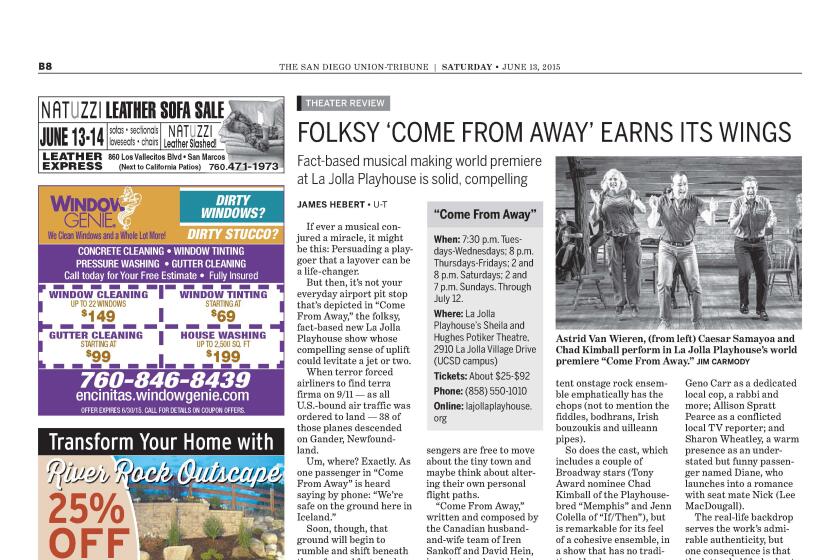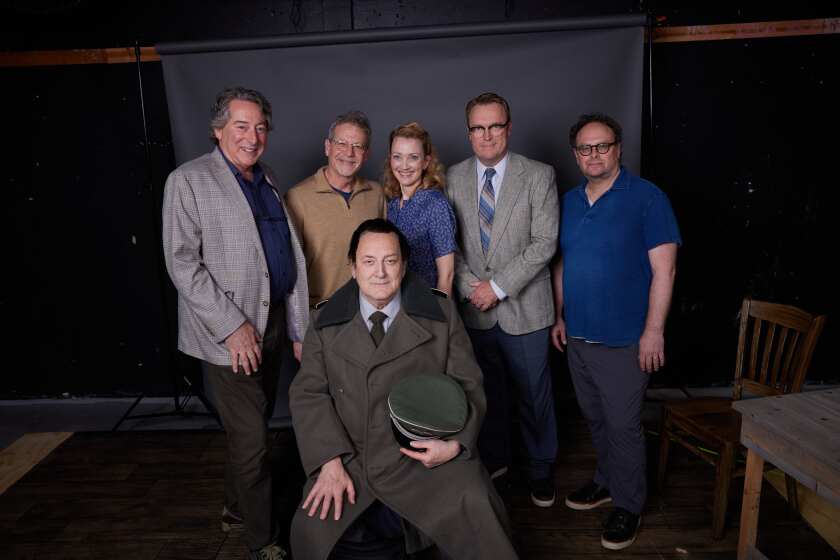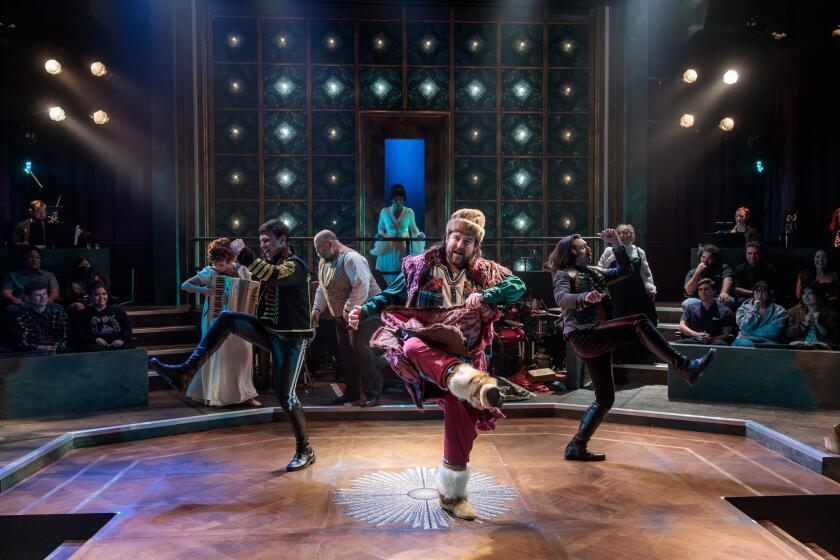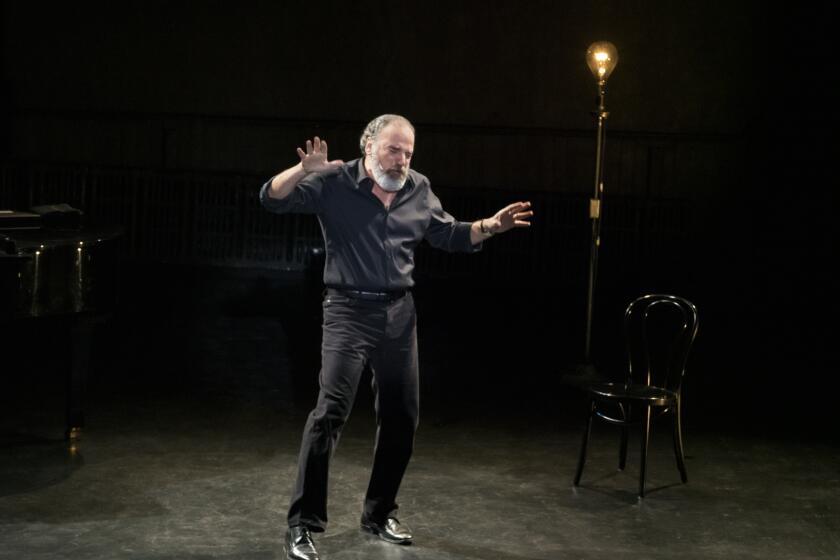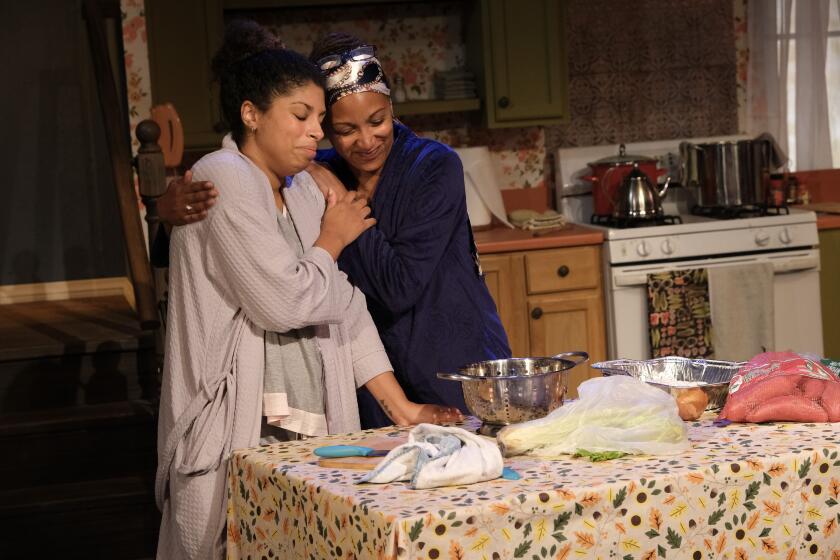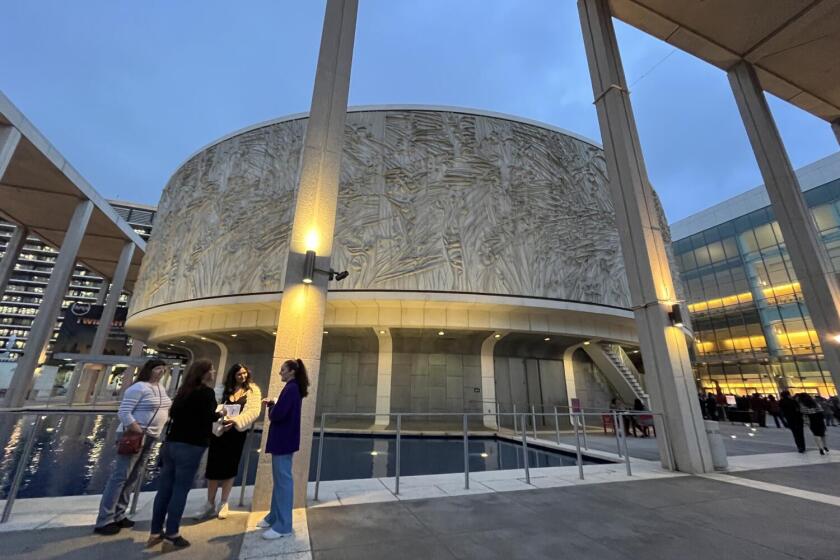African-American theater in San Diego
African-American theater as an institution and a movement has a rich history in San Diego, dating at least to 1963 and the founding of Southeast Community Theatre.
That company still exists (now known as Common Ground Theatre), and several others have sprung up in the ensuing decades — Black Ensemble Theatre, Community Actors Theatre and the Ira Aldridge Repertory Players prominent among them, along with the annual Kuumba Fest (taking place through Monday at San Diego Rep).
The rise in influence and importance of such theaters and their work was embodied early on by Floyd Gaffney, the much-admired director and educator who helped shape both African-American theater here and the University of California San Diego’s now nationally renowned theater program, which he served as a faculty member for 23 years starting in 1971.
Much has changed on the San Diego theater scene since Gaffney was working with Southeast Community Theatre in the 1970s. As the number of regularly producing companies in this vibrant theater town has exploded, the proportion of active theaters dedicated to African-American-centered programming hasn’t seen the same kind of growth.
And yet stories of the African-American experience (and those of other ethnicities as well) have increasingly found their places in the larger theater world here — a development that incontestably owes much to the work of Gaffney (who died in 2007) and his fellow pioneers.
With that background in mind, we asked a half-dozen prominent local theater-makers of color — several of whom lead companies devoted to African-American stories — to share their thoughts on the shifting cultural role and the long-term mission of the African-American theater presence here.
JENNIE HAMILTON
Artistic director, Community Actors Theatre
When we first started, we felt we needed a theater to showcase our talents freely; to tell the history and stories of our culture and that of our ancestors. Theater for us has been like a roller coaster. The struggles have been hard, but we knew that someone needed to do this; to carry the mission on.
We tell the stories of African-Americans to keep the stories alive and to have everyone see, hear and enjoy them, as well as learn from and about the history of African-American theater. This is crucial so as not to let the stories be lost or forgotten. Providing the opportunity and the forum for this to continue to happen is very important.
I strongly feel that other theaters are now including the work of African-American theaters as a result of African-Americans sharing their stories and including everyone in the acting and learning process. It has given many a better feeling for and understanding of the work, the culture and the history, and why it can be beneficial and educational as well as entertaining.
To my knowledge, Community Actors Theatre is the only African-American theater in San Diego with its own facility. Because we have our very own venue, we can offer more productions a year, plus acting workshops for all ages on a regular basis.
RHYS GREENE
Artistic director, San Diego Black Ensemble Theatre
I don’t believe I’ve seen the makeup or mission of African-American theater change in San Diego. The few theaters of color are still around and are sticking to what they’ve been doing. But as I think about it, I must say (Jennie) Hamilton at Community Actors Theatre has expanded its artistic programming in the last few years.
I believe the audience is the same audience that has always gone to see plays. Now their children are going to see plays, and of course local actors make up part of that theater-going audience. It seems the African-American theater companies are always pushing audience development, trying to expand the theater-going experience to the African-American community.
I’ve never felt that theater companies dedicated to reliving the African-American experience onstage has been a crucial part of the theater ecosystem here in San Diego. It’s always been on the fringes of the theatrical main stage, and continues to be so.
What I’d like to see for the African-American theaters here is a dedicated performing-arts facility, with the city as its building fund partner. As artistic director of the San Diego Black Ensemble Theatre and a board member of a few theater companies here in San Diego, my current mission is to find an affordable space that would house two to three companies and be an artistic home for artists seeking a place to work.
KAJA DUNN
Actor, director and theater faculty member at California State University San Marcos
I feel that with the exception of a few companies, African-American actors have less of a presence on San Diego stages than they did when I got here; however, I see more African-Americans in the audiences for theater.
I think something that I am seeing with my generation and the students I teach is a hunger for more diversity in the type of stories told about the African diaspora. They want to see themselves onstage, and they are looking for bold contemporary stories that reflect their lives.
I think one of the things that is sometimes missing when companies produce African-American theater is the sense of subtlety or the multiple perspectives that young African-Americans live with. Especially in San Diego, we exist in a multicultural environment,and that is not how our stories are always reflected onstage.
I feel we have a few strong theater-makers who are dedicated to getting true reflections of African-Americans onstage. I know with Moxie Theatre and (artistic director) Delicia Turner Sonnenberg, one of their missions is to train not only artists but audiences and decision-makers who can support artistic institutions and serve on committees and boards. Leah Goodwin, Dea Hurston, Starla Lewis and Delicia have all been instrumental in mentoring the next generation of black theater-makers. I would like to see more young African-Americans with more of a presence among the artistic leadership.
I would like to see more space at some of the larger theaters for African-Americans to have a seat at the leadership table. It is hard to be honest about what you see and feel when you are also hoping for those companies to hire you, and you are the only person of color around the table or you are working in a contingent position.
Going forward it is my hope that we see more work that breaks the mold and stereotype of African-American theater. The shows coming up at Moxie, and some of the work at La Jolla Playhouse and San Diego Rep have started to head in this direction. Because I am a teacher in addition to being an actor and director, I work with young African-Americans all the time who want a chance to see themselves in a contemporary light not just in musicals or pieces from the Black Arts Movement (as wonderful as it is).
ANTONIO “T.J.” JOHNSON
“Actorvist,” director and educator; founder-director, Vagabond Projects; former head of Black Ensemble Theatre
I’ve been a part of the theater scene here since 1981, and I have seen different aspects of theater change in many different ways. Early on a black show was considered an event that all the black actors in town would audition for and all the black audiences would flock to see.
Over the years I have noticed a change. It seems to have started with August Wilson’s “Century Cycle” becoming so popular in town and nationally. In town the Old Globe has produced Wilson, and with their ambitious fall project Cygnet Theatre will have produced half of the Cycle. There seemed to be a shift in when and where theaters were producing black plays. The new writers like Lynn Nottage and Suzan-Lori Parks were being produced, along with the rebirth of Lorraine Hansberry and Amiri Baraka pieces popping up all over town.
There was a change happening; you could feel it and see it. Black actors were beginning to get known with positive reputations. They were starting to cast black actors at the larger theaters in town. Black actors were being singled out for awards and more opportunities were opening. At one point we had five black artistic directors and other black directors producing and directing throughout the city.
There seems to have been a drop-off in that area lately. It doesn’t seem that we are developing the support and infrastructure needed to sustain and build the tradition of theater in the community. African-American theaters struggle with lack of resources and financial support, like all theaters, making it hard to consistently produce representative shows in the communities that are trying to build audiences.
Theater is a quilt that weaves together stories of diverse experiences to give us lessons of life and entertain us, while connecting us emotionally and spiritually.
CALVIN MANSON
Founder and artistic director, Ira Aldridge Repertory Players
The mission remains the same, to tell the stories of African-American culture, identity — the African-American experience. It is also to provide a platform for African-American writers, directors and actors to enter into the theater community.
African-American experience is a crucial part of the theater ecosystem here in San Diego and elsewhere; the focus on the issues of race has brought about another period of the kind of activism and social awareness that provided the push to theater companies in telling African-American stories.
When an 80 percent white audience goes to a black play at a white theater company, they gain something from the experience but then go away. When they go to African-American theater, devoted to telling the stories of African-Americans, they not only experience the play, they also experience a different culture.
All theaters need to constantly diversify their audience or they will die. The major theaters in San Diego will have to do the same, if they have not already.
The difference in the theater scene now is a perception that the only place to see theater is at the major companies. This is reflected in the general public and what shows the critics review. The general public now believes that the place to see African-American plays is at those major theaters. I believe this is very different from 20 years ago, when community theater was a greater part of the ecosystem, because community theater was the only place you could see theater of color.
MONIQUE GAFFNEY
Actor and playwright
I’ve had the great opportunity of witnessing the evolution of African-American theater in San Diego. I’ve seen it unfold as the years have passed and the demographics have changed. My father, the late Floyd Gaffney, was a major force in integrating black theater into San Diego. There was very little black theater when he first arrived, and he wanted to help spearhead a movement to give actors of color an opportunity to train, perform and share their stories.
In particular, when he served as artistic director of Common Ground Theatre (then known as Southeast Community Theatre), I found myself in the unique position of seeing the creation of art, right before my very eyes, and watching it blossom into a full production.
Audiences have changed to a degree, but there is still a wide gap. African-American theater is marginalized, but I do see more of it. I realize many of our stories would force audiences to wrestle with ugly parts of American history, but I believe that’s the beauty of theater. It would be nice if the community becomes evolved enough to recognize that every story is a human story regardless of race, religion, class or other.
I believe it’s vitally important for theaters here in San Diego not only to tell stories about the African-American experience, but to tell the stories of all people of color. It’s about representation and celebration. It’s also about having the opportunity to work as an actor locally, and having a place to create work.
More than once, I’ve found myself wanting to leave and find more work elsewhere. Although one of the occupational hazards of being an actor is the constant search for employment, it’s made much more difficult when opportunities are limited. The struggle occurs when this lack of opportunity happens because I’m only seen as a black actor, instead of just an actor. When people unintentionally set this kind of limitation, it can be extremely frustrating and hurtful. As an actor, I want to consistently work, and for me, African-American theater is essential.
Get U-T Arts & Culture on Thursdays
A San Diego insider’s look at what talented artists are bringing to the stage, screen, galleries and more.
You may occasionally receive promotional content from the San Diego Union-Tribune.

